Yellow perch are native to ponds throughout Cape Cod and southeastern Massachusetts. Fishing for yellow perch with lures and live bait can be very productive and a lot of fun, especially during late winter and early spring before the stripers arrive.
An added bonus is that yellow perch are also a very delicious fish to eat! They have firm white meat which is wonderful when pan fried. Plus most anglers I know who eat yellow perch prefer to eat them now (and during the winter) when the ponds' waters are still icy cold.
In this post we'll dive deeper into fishing for the colorful and beautiful yellow perch, and re-visit a memorable trip I filmed a couple of years ago on March 10th, 2021 with MFCC member Jeff Coates at a pond that was almost on Cape Cod, in town of Plymouth.
About Yellow Perch

The average size for yellow perch is between 4 and 10 inches, however on Cape Cod and southeastern Massachusetts they can grow to be much larger.
In fact, the world record for yellow perch is an 18 inch 4lb 3oz fish. The perch was caught in New Jersey way back in 1865 which makes it the longest-standing record for a freshwater fish in North America.

As their name suggests, yellow perch are quite colorful, with a pattern of 6-8 dark vertical bars over a background color of yellow or yellowish-green.
Yellow perch reach sexual maturity within 2-3 years. They gather in large schools each spring and spawn in shallow water. These schools can contain upwards of 200 individual fish, and are an important food source for largemouth bass, cormorants and other species.
On Cape Cod and in southeastern Massachusetts you can find yellow perch along the shoreline among weeds, docks and other structure. They seem to thrive in weed-filled ponds with a mucky bottom, as opposed to deep and open water lakes.

Yellow Perch Fishing 101
It was a cool and breezy morning when I woke up at 4am on March 9th 2021, so I made sure to bundle up. The forecast was calling for gusty winds, but fortunately the pond we'd be fishing was small and protected.
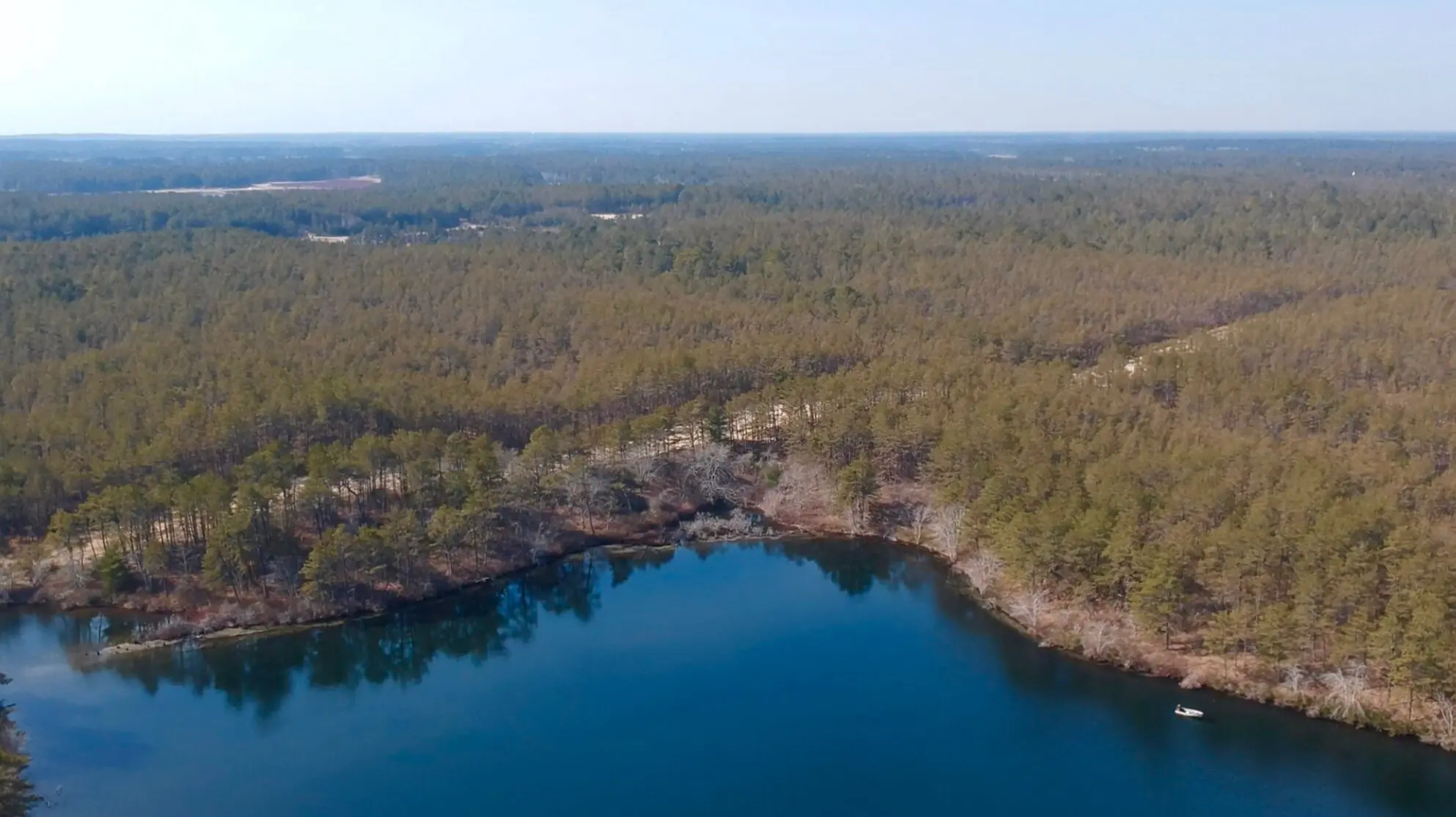
By 6:30am we had arrived at the spot and the first thing I noticed was the peace and quiet. It was a refreshing feeling to be back in the woods and surrounded by nature.

I was excited to hop in the Jon boat and get underway via trolling motor power. Fishing from shore is always fun, but the Jon boat would allow us to go straight to where the big schools of yellow perch were hiding.
MFCC Member Jeff Coates
During this trip I would be fishing for yellow perch with My Fishing Cape Cod member Jeff Coates. You might recognize Jeff from his insightful posts inside our private forum.
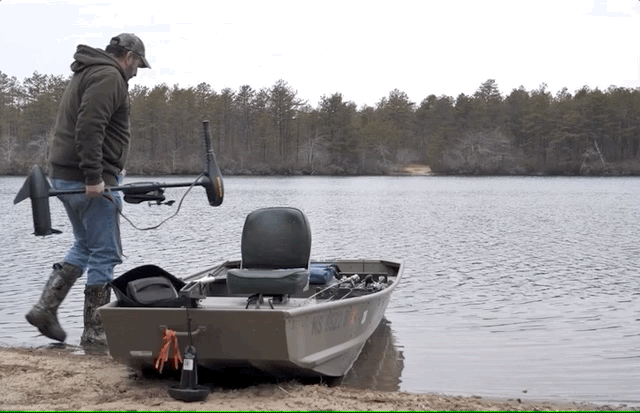
I first met Jeff when I was a teenager working at a small bait and tackle shop, and we've been sharing fishing information and tips with each other ever since

Jeff has always been pretty dialed-in on the local freshwater fishing bite, so I jumped at the opportunity when he invited me to go fishing for yellow perch. Like most great fishing spots, Jeff discovered this area by spending hours on the water and putting his time in.
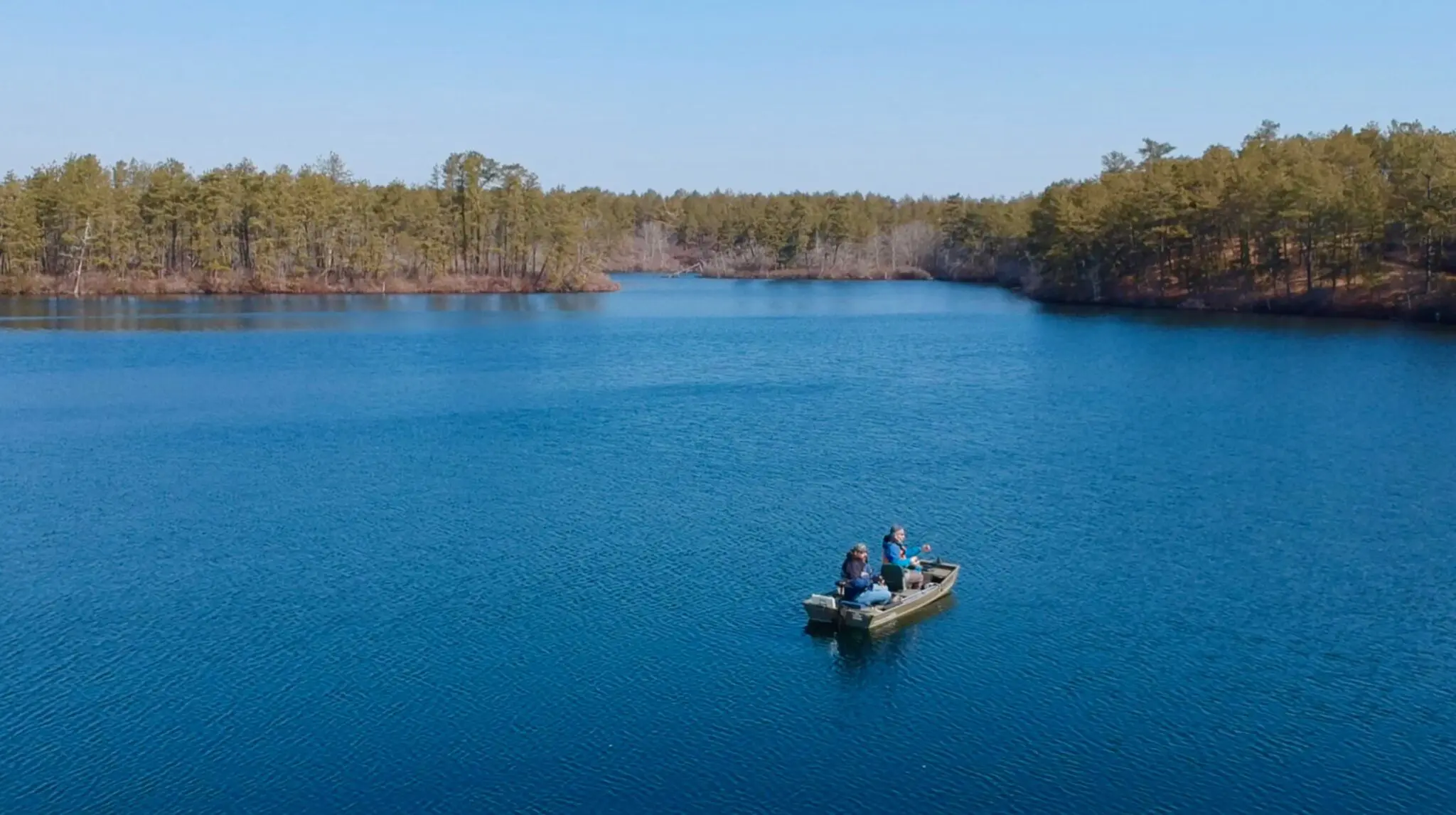
Bait, Technique and Gear
For bait we used live shiners and chubs fished just off the bottom. We used a 5/16 ounce weight with a size 1/0 hook that was tied about 12 inches up from the weight.

The way Jeff rigged this was by tying a Palomar knot to the size 1/0 hook and leaving 12 or more inches of tag line, which was then used to tie on the 5/16 ounce weight. Please remember that lead weights are prohibited from use in freshwater ponds in Massachusetts.
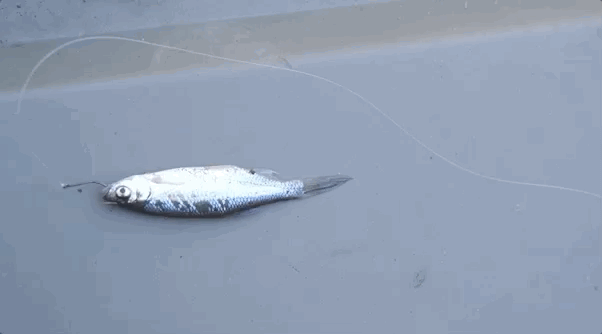
Yellow Perch Blitz!
Jeff started up the trolling motor and we glided along the tranquil surface of the pond, towards his yellow perch honey hole.


We began by fishing a drop off, where the bottom went from 7 to 10 feet. There was also grass growing along the bottom in this spot.
The bite was on from just after sunrise until maybe 8:30am. A school of yellow perch had taken up residence on the deeper side of the drop off, and we were able to experience some fast and fun fishing.
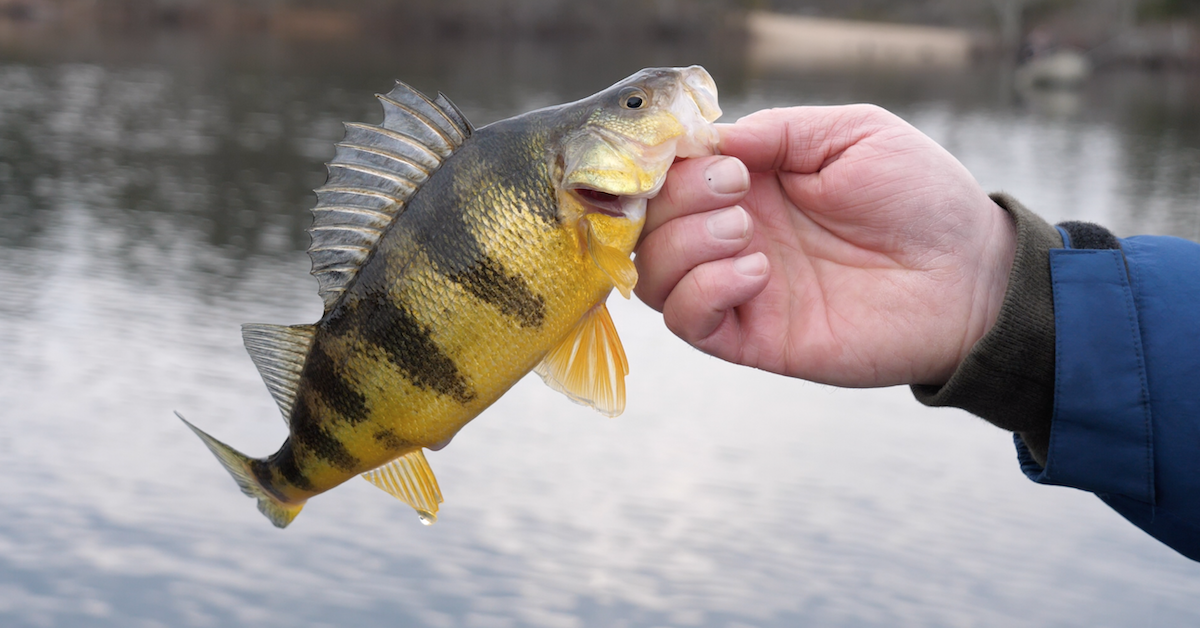
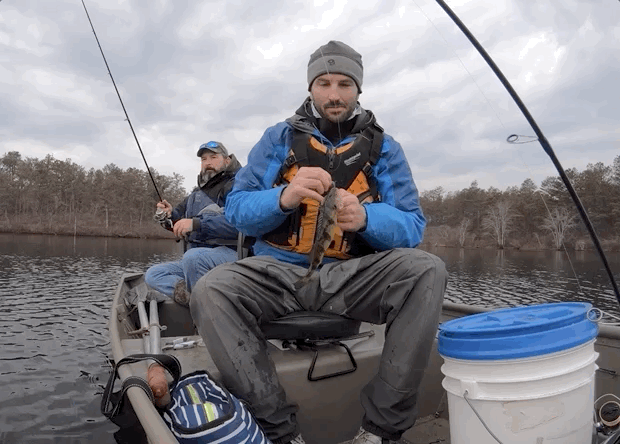
After 8:30am the bite really slowed down for us. Yellow perch can change locations quickly, and they will even go into very shallow water along the shoreline.
This is especially true during early Spring as they prepare to spawn. Jeff even told me the perch will occasionally hold beneath the branches and bushes which over hang along the shoreline of the pond.

Largemouth Bass
We decided to search the shore. Jeff manned the trolling motor as we cruised along quietly in just a few feet of crystal clear water. I stood at the bow and scanned the bottom, trying to spot the schools of yellow perch.
It didn't take long for us to search the circumference of the small pond. Jeff caught a solid largemouth bass, and we spooked a few other 15-19 inch long largemouths which were holding near fallen timber.

However, the perch were now proving elusive. Jeff and I figured the perch were probably still holding in the same general spot, but that they had just stopped feeding.
We had caught over a dozen jumbo yellow perch and had kept eleven, and we felt like that was enough-there was really no need to take any more. Jeff let me bring home the fish and I'm happy to report they were delicious eating!
We packed it in around 11am and called it a trip.

Yellow Perch Recipe
Before I dive into the eating portion of this report, I think it's important to remember to never take more fish than you need. Yellow perch are abundant throughout North America, however I would imagine it's possible to overfish them from individual ponds.

I took home eleven yellow perch from this trip and that was plenty enough for my wife Lauren and I. Odds are I probably won't bring home any more yellow perch until next year. Personally I'm treating it as an annual event and something to look forward to. The last thing I want to do is risk taking too many fish.

Yellow perch are not the easiest fish to fillet, and I would imagine you'll get more meat if you cook the fish whole. Nevertheless after taking my time and doing as best a job as possible, I ended up with a big bowl of nice white fillets. I did notice a few worms in the flesh which I easily removed with the tip of my knife.

In our house we don't often fry fish because the oil inevitably splatters on the stove top and makes a mess. However, I insisted that we fry the perch, because I was literally dreaming about the crunchy breading and white flakey goodness that only frying can produce.

Lauren decided to spice things up by adding parmesan cheese, dried mixed Italian herbs, basil, garlic seasoned salt, pepper, dried thyme, and a pinch of red pepper flakes to the breading.
She first dredged each fillet in flour before dipping the fillet in egg and rolling it in the breading. It then went into the frying pan which was filled about 1/2 an inch with olive oil. The fish only took a minute or so on each side to cook.


The result was exactly what I had been dreaming about! The perch was so crunchy and flavorful that I almost lost my senses. We paired the fish with a side dish of twice-cooked lemon orzo pasta and asparagus.

All in all it had been a complete experience, from catching, to cleaning, to cooking. I consider myself very fortunate to have enjoyed a meal of wild caught freshwater fish, in an age where almost all of my sustenance comes from store bought foods.
In Conclusion
Fishing for yellow perch during March can be very productive if you are able to locate a nice school. The added bonus of frying a few of these tasty fish up makes it a complete outdoors experience.
Good luck if you are able to make it out freshwater fishing this week. As always, please let me know what you think by leaving a comment below!
Tight lines

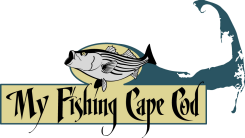


Love the videos of the Perch. They are a very pretty fish. Laurens recipe looks fantastic. I haven’t harvested a fish from shore yet. It’s a soft goal of mine for 2024! Great work Ryan!
Excellent As Always, Cap!
Especially recipés !
Tight Lines from Poppy
Hey Chris, I’m glad you enjoying the posts and recipes! Spring is here and it won’t be long until the warm weather arrives. Keep in touch this season!
I stumbled on a great use of Yellow Perch many years ago in New Hampshire while fishing for Smallmouth Bass. I was fishing out of a canoe in 30 feet of water on Lake Winisquam. I caught a Yellow Perch from the bottom with a worm on a small hook while using a slip bobber . As I brought the Perch to the surface, a 5 pound size Smallmouth came up from the depths and skittered along the surface trying to eat the Perch. It didn’t get hooked as the hook for the Perch was too small. Aha moment! I put the Perch on a Bass sized hook and dropped it to the bottom. The Perch was soon taken by a big Smallmouth and a very effective system was discovered. This would also work when ice fishing. Live lining bait fish is one of the most exciting ways to fish, especially with a float.
Nice Dex! It’s not often I hear you speaking about freshwater fishing. Thanks for sharing that insight! I’ve also read that yellow perch make great bait for bass, but I have never tried them before. Maybe I’ll give it a shot after reading about your experience. Thanks!
Ryan,
Early the next morning on the same lake I was fishing from a dock using some saved live perch from the day before. I hooked the perch about three feet below a traditional red and white bobber and cast it out. The Perch was immediately surrounded by a group of about 5 big bass and a few big pickerel who came up from deeper water nearby. The biggest bass grabbed the perch and while it was hanging hanging out of the bass’s mouth, a pickerel attacked the bass and took the the Perch away! I ended up catching the Pickerel but I wanted the Bass. The water was crystal clear so I could see it all happening in the span of about a minute. It was just like Fish TV!
It’s great how that experienced has been burned into your memory. I could imagine the scene unfolding as I read your comment. Love it!
I spent all winter catching yellow perch, white perch, and crappie in the Charles River on barely open water. They school up in several spots and are easy to catch. I even took my wife, son, and daughter out and everybody loaded up.
The unfortunate problem is the fact the state says you can’t eat these fish from there or most places in Massachusetts. Do you have a list of freshwater locations where it is safe to catch and eat fish?
That sounds like a great way to spend the winter Dwight. Regarding your question, here is a link to some helpful information about bag limits in Massachusetts. My interpretation of the information on the mass.gov website is that anglers are able to retain fish from many ponds, lakes and rivers throughout the state. Check it out and LMK what you think, and thanks for reading MFCC! ?
Thanks for the info Ryan,
It is good to know what we can retain on a seasonal basis. I saw some helpful links in there that went into the topic of safely eating fish. What do you think? My wife has lived here her whole life and can’t fathom taking anything freshwater home.
https://www.mass.gov/info-details/eating-fish-safely-in-massachusetts
https://www.mass.gov/lists/fish-consumption-advisories
https://www.mass.gov/doc/public-health-freshwater-fish-consumption-advisories-2020/download
Hey Dwight, with regards to eating the fish, I suppose it boils down to your personal comfort level. I’ve only eaten freshwater fish that were caught during the cold winter or early spring months. They were taken from ponds which are fairly “remote” and are not surrounded by houses and development. The water was clean-looking and aside from some trash here and there, the ponds were as close to “pristine” as is possible these days. I feel pretty comfortable eating fish that came from waters such as that.
Hey Ryan…Great article..Almost fainted when I saw you went fishing with Jeff Coates..I have known Jeff since he was a very young lad…He went to School with my brother Rob from the Hoxie School to Bourne High..My dad coached both of them in minor and little league baseball,most games played at the field in Sagamore beach..He was a great kid…Haven’t seen him and ages say hi to him for me when u see him again ,Hope he remembers me…lol
Hey David, good to hear from you! Thanks for your comment, and it’s good to know that you also know Jeff. Your mention of the Hoxie brought back memories because I also went to elementary school there. I will definitely let Jeff know you say hi! ?
We are fortunate that our Cape Cod “happy place” is on a beautiful kettle hole in Eastham. First our kids and their cousins caught their first fish there and a lot of yellow perch. Now our grand kids fish and have semi-friendly debates about who catches the most and who catches the biggest. I get to referee with the official scale and yard stick on a nearby pine. By the way they are all released, except the first good size large mouth that each kid catches. The kettle holes of the Cape are treasures we should all work to preserve.
Well said Mark. Thanks for the comment! Your “happy place” in Eastham sounds like paradise to me. ?
My favorite fish fry is yellow perch. Will be on the water
for them in a few weeks here in central NY. Glad you were
able to find some Ryan!
Nice Tom! Yellow perch are definitely delicious when fried. Good luck out there in a couple weeks!
Good job!
yellow perch was the 2nd fish I caught when I was about 7 or 8 years old. The first was a sunfish in Jamaica Pond. Later in life my wife and I used to catch TONS of white perch in Long Lake and Brandy Pond in Maine – also great for pan frying. I love the way you continue to expand your fishing experiences and coverage thereof. Please send me your snail mail address so I can send you my annual dues as every year.
Tight Line,
Gene
P.S. Were you and Lauren unable to go to Costa Rica this year due to Covid-19?
Thanks for the comment Gene! I’ll send you an email today with my snail mail address. And we did go to Costa Rica this year and had another amazing time. I’ll fill you in via email. Thanks!